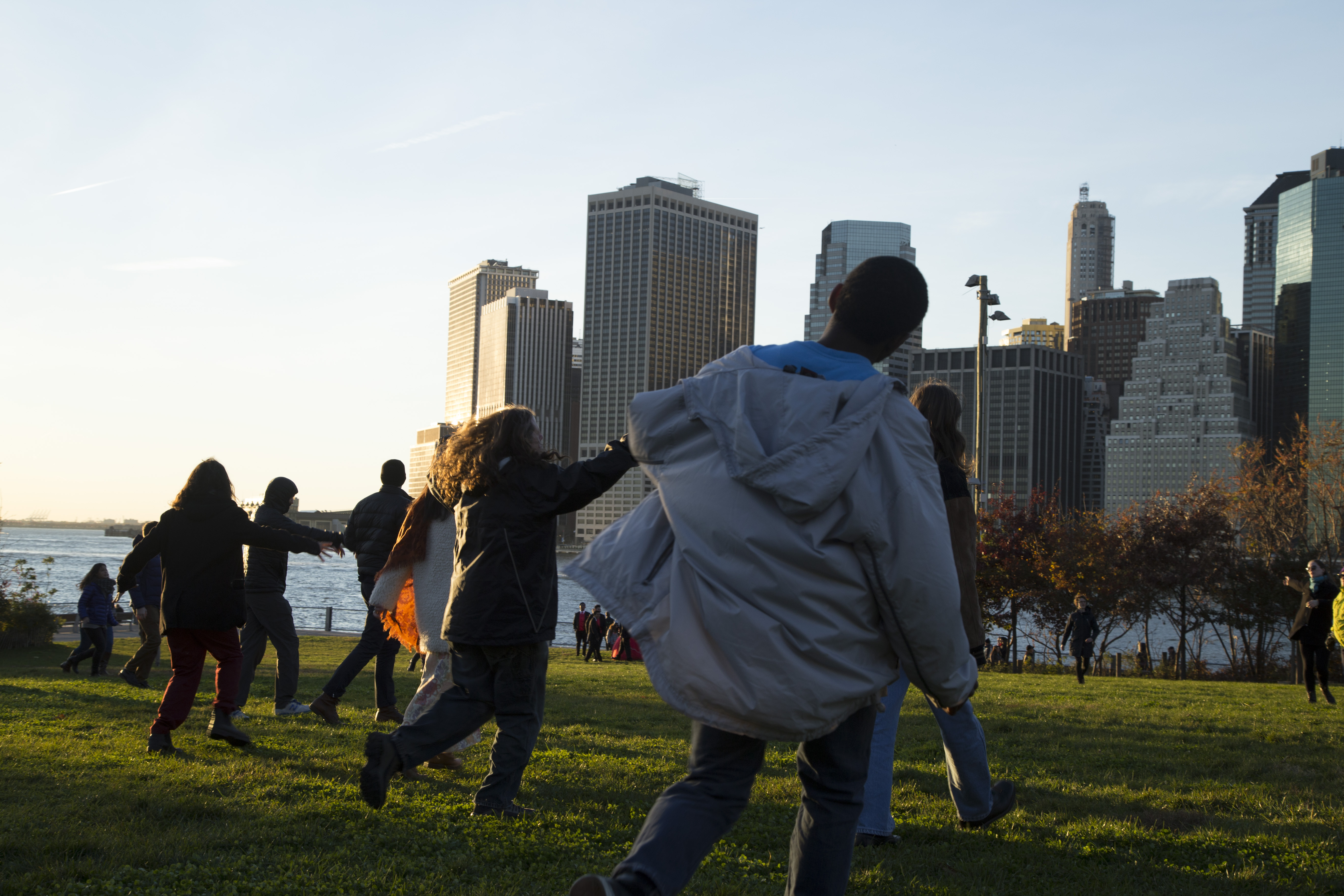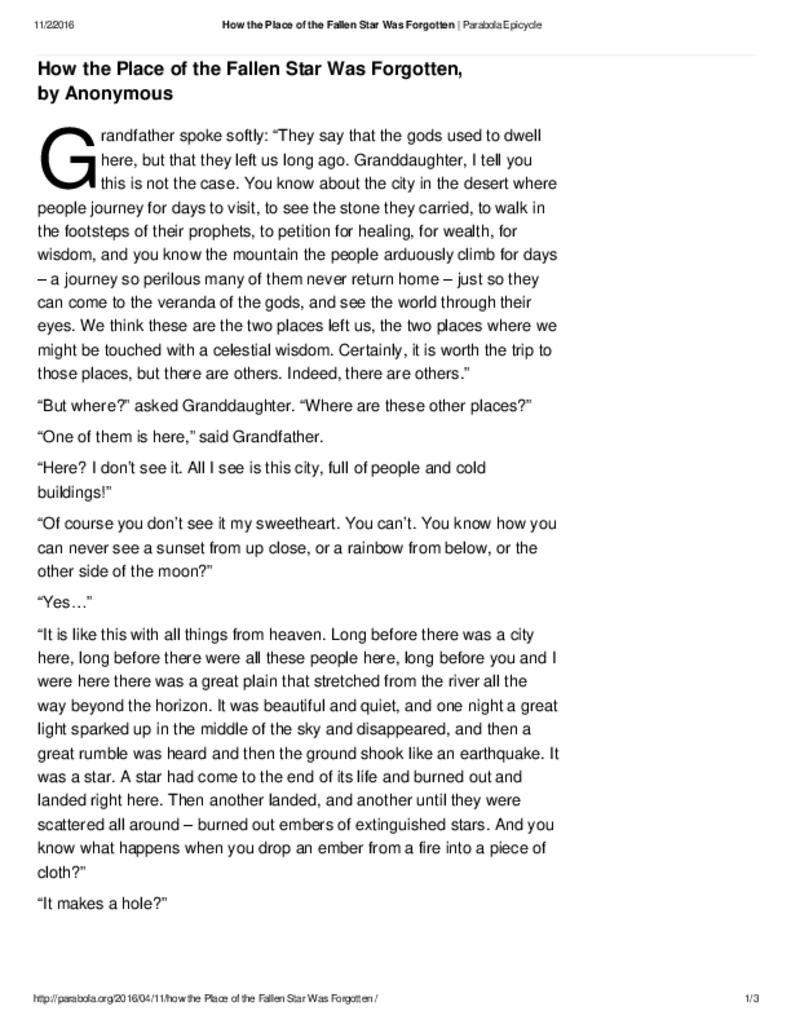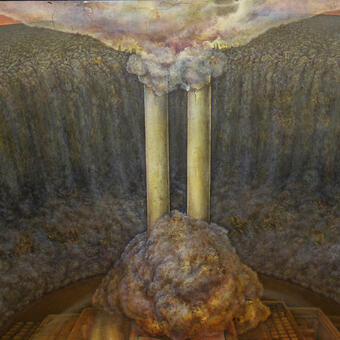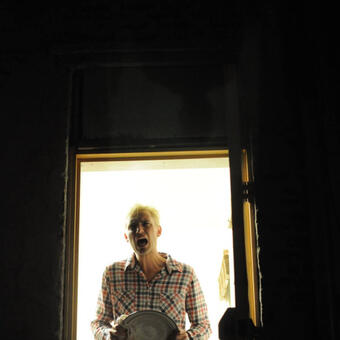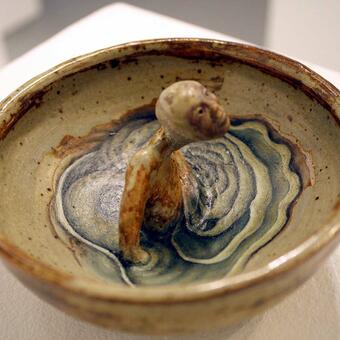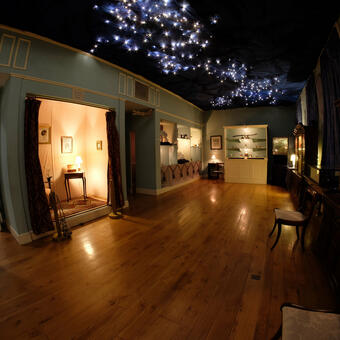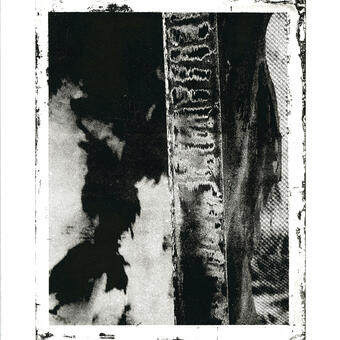About Abraham
Baltimore City
Abraham Burickson is the co-founder and Artistic Director of Odyssey Works, a cross-genre collaborative of artists which continually strives to challenge and re-conceptualize traditional notions of experience design, performance, and the artist-audience relationship. The work, in which performances are made for small and intimately known audiences, has been called by the New York Times: “A beautiful inefficiency [for] a small but infinitely more affected audience.” Trained in… more
Jump to a project:
Pilgrimage
Imagine, if you will, waking up one day to find yourself immersed in a performance that is all about you. Now imagine that you are the main character in that performance, that it goes on for months, that it takes place in your home, at your workplace, all over the city where you live, and that the other characters are your friends and family and a mysterious group of artists, most of whom you’ve never even met. This is Odyssey Works, and if this is happening to you it is because, some six months earlier, you were selected to be our sole audience member from more than one hundred applicants.
In 2002, I began the Odyssey Works project and have since worked with hundreds of artists in attempting to find a way to make more meaningful and impactful work. An Odyssey Works production is more than just a performance, it is a seamless infiltration of narrative and aesthetic themes into a person’s life. My team writes and publishes books claiming to have been written by the likes of Italo Calvino and Jorge Luis Borges, then hacks Wikipedia and even the New York Times to validate their authenticity. They also compose scores, create plastic objects, take over hardware stores, cafes, even former military ships in an effort to transform the mundane world into one rich with story and meaning. An Odyssey Works participant may find that all the new people he has been meeting have turned out to be actors, and that they are leading him to understand the city as a large map by walking across it carrying nothing but a rock, and that later he will be blindfolded and kidnapped and then taken to the woods where tinder is piled about his feet and that he’s tied to a stake, about to be burned alive. Or he’ll find himself nailed in a coffin, or awakening in a new life in a new home with people he’s never met posing as his new family. Or something else.
My most recent production, which took place in November of 2016 in New York, Baltimore, and Virginia over a week long period, was called Pilgrimage because it was structured in many ways as a pilgrimage.
Pilgrimage was also my first production since moving to Baltimore - first, I hope, of many. It was a wonderful opportunity to work with local artists (such as Graham Coreil-Allen, Laura Wexler, and Nate Brown) and to engage the sublime mysteries of my new home. It was also my first chance to work with Dare Turner, whose Native American (Yurock) heritage and her expertise in medieval pilgrimage rites heavily influenced the work.
Pilgrimage was a pilgrimage. Ayden LeRoux, for whom the performance was made, was facing many life changes - imminent surgeries, the threat of breast cancer before the age of 30, changing jobs, moving out of state, finding her life path. She was also someone who had recently taken a tour of the land art of the American West and found it to be deeply spiritual. Pilgrimage was something that was on her mind, and it seemed she should take a properly structured pilgrimage.
It would be too much to describe the performance as a whole (if you would like a full narration, you can check out the incredible essay written by Maura Callahan in the January 2017 cover story for the Baltimore City paper here), but I would be remiss if I didn't introduce the project with a little more about the pilgrimage itself. Working closely with Turner, we studied the specific structures of pilgrimages - how pilgrims move from station to station, how they carry votive offerings to the holy sites, how the holy sites are shrouded in myth, how pilgrims accumulate badges and pendants, and how the clothes pilgrims wear are designed to ward off evil and danger. We found, amazingly, that many of these practices tracked with Turner's own Native traditions, and we worked with her mother to create regalia and clothing that she filled with protective prayers.
Through the more that 200 miles of her journey, as she was wrapped in peoples wishes like a cocoon in Brooklyn Bridge Park and then transported southward, as she spent the night in an unknown pilgrim house (in Baltimore) as she walked and rode trains and the light rail and hiked along rivers and canals, her pilgrimage tracked a long tradition of pilgrimages - both European and American. But the end point of her pilgrimage was something much newer, a piece of land art by Nancy Holt (arguably the only land art on the east coast).
As Ayden walked, we walked. Everybody who was involved in the performance deeply enough went on the pilgrimage as well, offered their own votive offerings, made their own petitions.
In 2002, I began the Odyssey Works project and have since worked with hundreds of artists in attempting to find a way to make more meaningful and impactful work. An Odyssey Works production is more than just a performance, it is a seamless infiltration of narrative and aesthetic themes into a person’s life. My team writes and publishes books claiming to have been written by the likes of Italo Calvino and Jorge Luis Borges, then hacks Wikipedia and even the New York Times to validate their authenticity. They also compose scores, create plastic objects, take over hardware stores, cafes, even former military ships in an effort to transform the mundane world into one rich with story and meaning. An Odyssey Works participant may find that all the new people he has been meeting have turned out to be actors, and that they are leading him to understand the city as a large map by walking across it carrying nothing but a rock, and that later he will be blindfolded and kidnapped and then taken to the woods where tinder is piled about his feet and that he’s tied to a stake, about to be burned alive. Or he’ll find himself nailed in a coffin, or awakening in a new life in a new home with people he’s never met posing as his new family. Or something else.
My most recent production, which took place in November of 2016 in New York, Baltimore, and Virginia over a week long period, was called Pilgrimage because it was structured in many ways as a pilgrimage.
Pilgrimage was also my first production since moving to Baltimore - first, I hope, of many. It was a wonderful opportunity to work with local artists (such as Graham Coreil-Allen, Laura Wexler, and Nate Brown) and to engage the sublime mysteries of my new home. It was also my first chance to work with Dare Turner, whose Native American (Yurock) heritage and her expertise in medieval pilgrimage rites heavily influenced the work.
Pilgrimage was a pilgrimage. Ayden LeRoux, for whom the performance was made, was facing many life changes - imminent surgeries, the threat of breast cancer before the age of 30, changing jobs, moving out of state, finding her life path. She was also someone who had recently taken a tour of the land art of the American West and found it to be deeply spiritual. Pilgrimage was something that was on her mind, and it seemed she should take a properly structured pilgrimage.
It would be too much to describe the performance as a whole (if you would like a full narration, you can check out the incredible essay written by Maura Callahan in the January 2017 cover story for the Baltimore City paper here), but I would be remiss if I didn't introduce the project with a little more about the pilgrimage itself. Working closely with Turner, we studied the specific structures of pilgrimages - how pilgrims move from station to station, how they carry votive offerings to the holy sites, how the holy sites are shrouded in myth, how pilgrims accumulate badges and pendants, and how the clothes pilgrims wear are designed to ward off evil and danger. We found, amazingly, that many of these practices tracked with Turner's own Native traditions, and we worked with her mother to create regalia and clothing that she filled with protective prayers.
Through the more that 200 miles of her journey, as she was wrapped in peoples wishes like a cocoon in Brooklyn Bridge Park and then transported southward, as she spent the night in an unknown pilgrim house (in Baltimore) as she walked and rode trains and the light rail and hiked along rivers and canals, her pilgrimage tracked a long tradition of pilgrimages - both European and American. But the end point of her pilgrimage was something much newer, a piece of land art by Nancy Holt (arguably the only land art on the east coast).
As Ayden walked, we walked. Everybody who was involved in the performance deeply enough went on the pilgrimage as well, offered their own votive offerings, made their own petitions.
-
Participant in her CocoonThe participant, wrapped in her cocoon by dozens of members of the public who joined us. The cocoon is comprised of sheets inscribed with people's petitions and will accompany her to Baltimore. photo by Xandra Clark
-
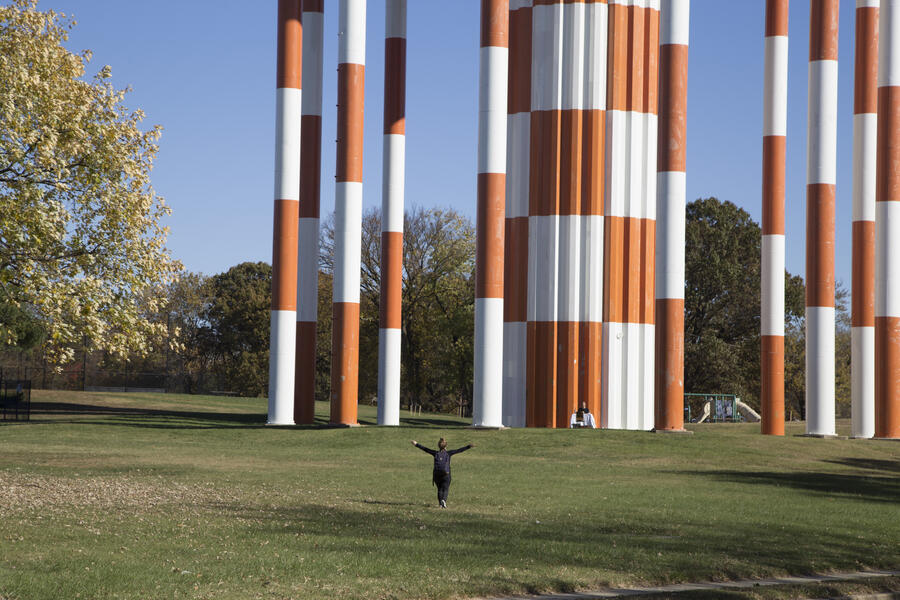 Linthicum EncounterIn Linthicum, MD, The participant encounters a friend who bestows upon her the pilgrim's tunic and regalia. This photo was on the cover of the Baltimore City Paper. photo by Katy McCarthy
Linthicum EncounterIn Linthicum, MD, The participant encounters a friend who bestows upon her the pilgrim's tunic and regalia. This photo was on the cover of the Baltimore City Paper. photo by Katy McCarthy -
The Participant in Her CocoonThe Participant in Her Cocoon. Photo by Xandra Clark
-
The Pilgrimage site in ArlingtonThe Pilgrimage site in Arlington. A candle burns while the pilgrims await Ayden LeRoux's arrival. Photo by Xandra Clark
-
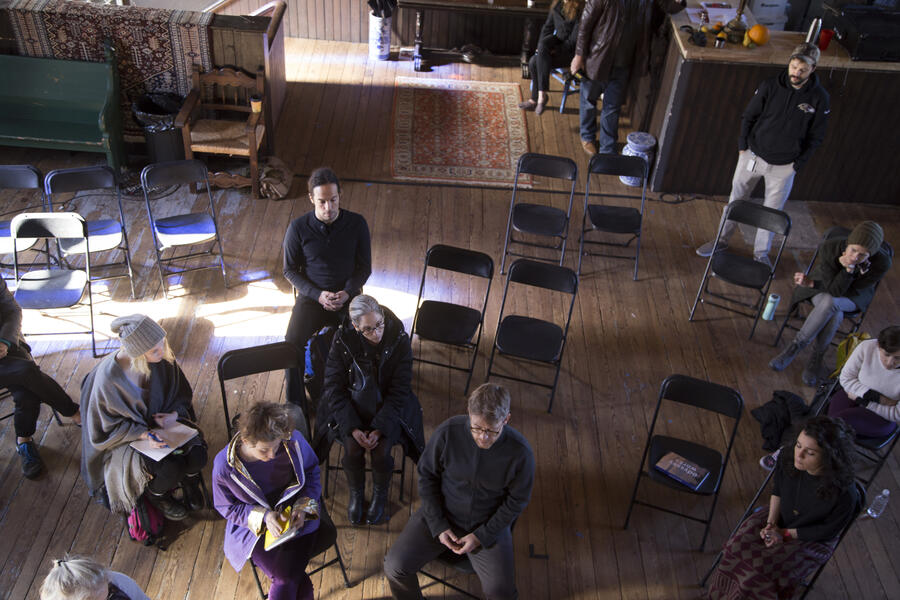 Baltimore Scene at Church and CompanyA Q&A with a twist. The "audience" who came to the book event brought their basic life questions rather than questions about the book. There were no answers, just a growing commonality.
Baltimore Scene at Church and CompanyA Q&A with a twist. The "audience" who came to the book event brought their basic life questions rather than questions about the book. There were no answers, just a growing commonality. -
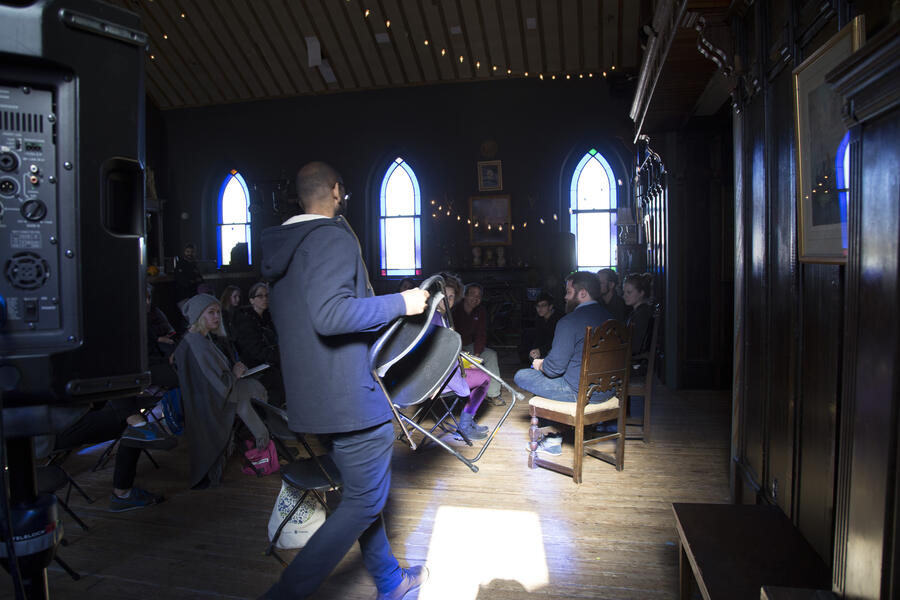 Baltimore Scene at Church and CompanyBaltimore Scene at Church and Company Photo by Katy McCarthy
Baltimore Scene at Church and CompanyBaltimore Scene at Church and Company Photo by Katy McCarthy -
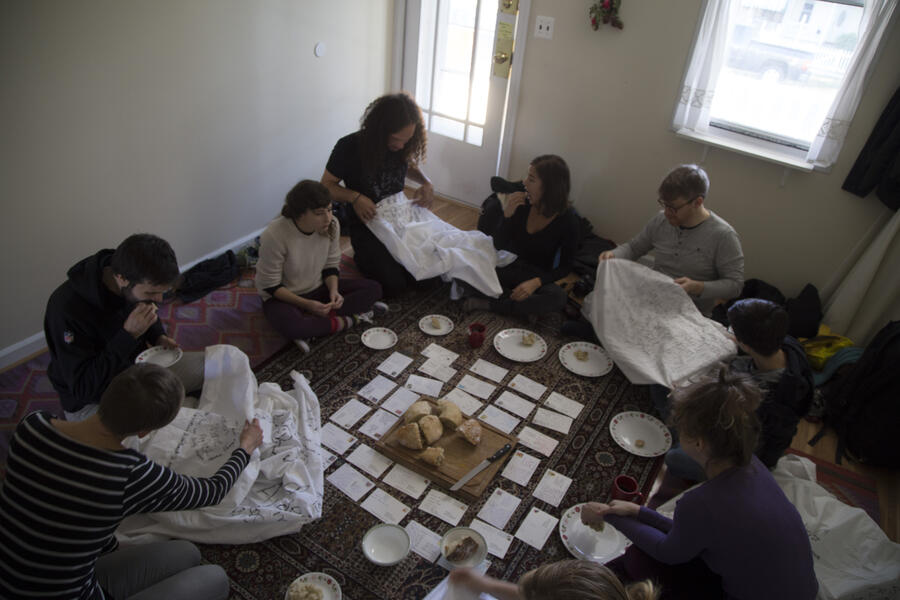 Pilgrim House in BaltimoreThe Pilgrim House in Baltimore. Pilgrims break bread (the only food they'll have on pilgrimage) and read postcards sent from fellow travelers around the world. Photo by Katy McCarthy.
Pilgrim House in BaltimoreThe Pilgrim House in Baltimore. Pilgrims break bread (the only food they'll have on pilgrimage) and read postcards sent from fellow travelers around the world. Photo by Katy McCarthy. -
 Public Scene in Brooklyn Bridge ParkA Public Scene in Brooklyn Bridge Park. Members of the public, choreographed on the day of the performance, join in a scene that will end in them wrapping the participant in a cocoon. Photo by Katy McCarthy.
Public Scene in Brooklyn Bridge ParkA Public Scene in Brooklyn Bridge Park. Members of the public, choreographed on the day of the performance, join in a scene that will end in them wrapping the participant in a cocoon. Photo by Katy McCarthy. -
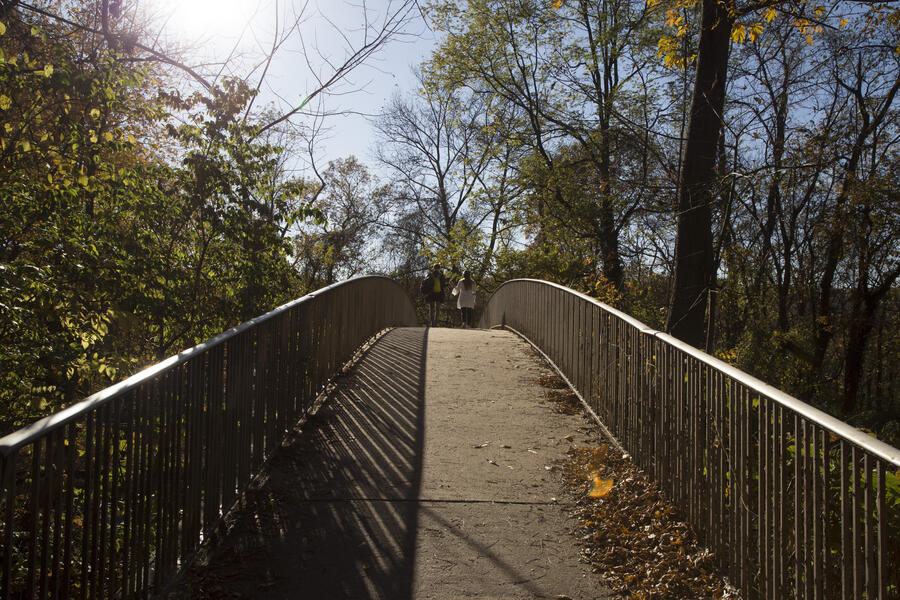 The Pilgrim on her JourneyThe Pilgrim wearing her regalia and pilgrim's tunic on her Journey on the C&O canal tow path. Photo by Katy McCarthy.
The Pilgrim on her JourneyThe Pilgrim wearing her regalia and pilgrim's tunic on her Journey on the C&O canal tow path. Photo by Katy McCarthy.





